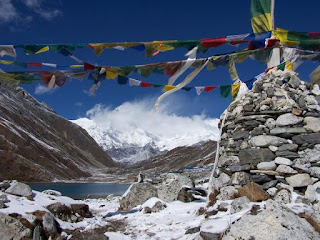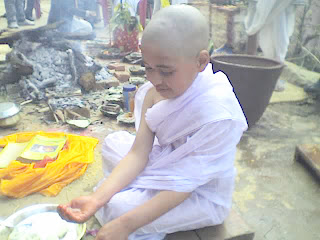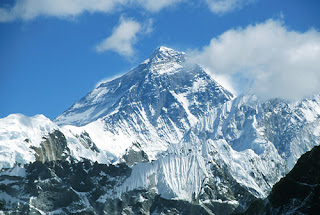
Khumbu (also known as the Everest Region) is a sub-region in Solu Khumbu located on the Nepalese side of Mount Everest.
Regions
The Everest region is officially called Khumbu and includes the Sagarmatha National Park (above Monju) and the Sagarmatha National Park Buffer Zone (between Lukla and Monju).
Villages
There are many villages scattered throughout Khumbu. Below is a list of nine of the most important to travelers. Others can be found on the 'Walk' section of the Everest Base Camp Trek
• Ghat - located between Lukla and Monju - small family temple and beautiful Mani stones and stupa
• Khumjung - good place to take an acclimatization walk when staying in Namche - sacred cave
• Khunde - near Khumjung - location of Khumbu's main Western medicine clinic
• Lukla - location of airport - other than for taking a flight, no compelling reason to remain here
• Monju - good place to stop on first night after arriving at Lukla
• Namche Bazaar - the unofficial Sherpa capital - restaurants, cafes, museums, Tibetan medical clinic
• Pangboche - picturesque village - small monastery
• Phortse- very traditional village on mountain opposite Tengboche
Other destinations
• Everest Base Camp Trek
Understand
Famous for its spectacular mountain peaks and the loyalty and friendliness of its inhabitants (the Sherpas), the Everest region (Khumbu) is one of the most popular destinations for tourists in Nepal. While many of the routes through the mountains are arduous, there are ample places to rest and enjoy a meal along the way. Furthermore, don't worry about getting lost. Just ask a local the way to the next village on your route, and they will direct you. Most Sherpas under the age of fifty can at least understand basic English, and many speak it fluently.
While trekking is possible in this area the whole year round, the best times to visit are from the beginning of March to mid May and from the beginning of September to mid November. The winters are very cold and snow may make it difficult to travel higher than Tengboche, and also lodges may be closed above this altitude. Summers, on the other hand, are wet, and the spectacular peaks often lost in the clouds. April and early May is a good time to see the hedgerows and trees bursting into bloom, with Rhododendrons, in particular, adding a spectacular splash of color to the landscape. However, dust from the plains of India during the spring routinely provide less than ideal conditions for clear mountain views. The views are much better after the summer monsoons have cleared the atmosphere of dust, but the days are shorter and cooler.
Trekking permits are not required for the Khumbu region.
Lodges and restaurants in Khumbu only accept Nepalese rupees. Budget between 600-800rs per person per day for food and accommodation - prices rise with the altitude, though you may spend more in Namche because there is more on offer. See Sagarmatha Park regulations:
Guru Rinpoche
It is not possible to travel far in Khumbu without seeing images of a man wearing a tall elaborate hat and with eyes that are open wide and staring forward into space. This is the great 8th century sage of Vajrayana Buddhism, Padmasambhava or Guru Rinpoche as he often called. According to legend, Padmasambhava was reincarnated into a lotus blossom as an eight year old child, and from very young he possessed great wisdom and insight. Furthermore, he had mastery of the elements and so like a potter manipulating basic clay and turning it into beautiful pots, he was was able to transform harmful action and substances into something positive and beneficial.
Guru Rinpoche is credited with introducing Tantric Buddhism into Tibet and is specifically associated with the Nyingma tradition, the form of Buddhism that the Sherpas brought with them when they migrated over the Himalayas into Nepal in 16th century. Sacred sites associated with Guru Rinpoche in the Sagarmatha region are the Maratika cave in Haleshi and a cave above Khumjung in Khumbu.
Talk
Sherpas speak their own language called Sherpa, which is related to Tibetan. Most Sherpas under the age of fifty can also speak English and Nepali. In addition, because many Sherpas have traveled overseas to work, it is not uncommon to meet Sherpas who are fluent in German, French and Japanese.
Get in
By plane
There are numerous flights plying the Kathmandu - Lukla route, though with a much reduced service during the off-season months. Sita is considered to be one of the more reliable airlines flying this route and operates two flights every morning from Kathmandu Domestic Airport at 7AM and 8:20AM, with return flights at 7:40AM and 9AM. Flights from Kathmandu take around 25 minutes. Be aware that during the summer rainy season there may be substantial delays, and even a wait of one week is not uncommon.
On foot
There is a bus running between Kathmandu and Jiri. From here to Namche Bazaar it is about a six day walk.
Just after the village of Monju, there is check point for entering the Sagarmatha National Park. Passports need to be shown and there is a 1,000rs entry fee.
Get around
On foot. There are no roads in the Khumbu region.
See
As a Zen poet once wrote: "Going deeper and deeper - still the green mountains". This could certainly have been written in Khumbu, but while the mountains are the obvious attraction, the area does offer many other sights.
Fauna
The national bird, danfe (a kind of pheasant), and mountain goats are common in the Khumbu area, and because the Sherpas do not kill animals or birds, people can often get very close before they take off. Musk deer and snow leopards are also natives of the Khumbu mountains, albeit more rare - keep that camera ready.
Do
Trek, eat, enjoy Sherpa hospitality and relish your time in such a beautiful and pristine environment.
Buy
Outside Namche, there are few souvenir shops and the handicrafts sold are similar to those on offer in Kathmandu. However, as the majority of goods are carried over from Tibet, which is much nearer to Khumbu than Kathmandu, you might find a few bargains and some unique items. Also, check out the clothing made from yak wool. This is often made locally, and so the prices may be lower than in Kathmandu. As in most parts of south-east Asia, remember to haggle for the best deal.
Eat
Most lodges offer similar menus - oatmeal, hash browns, omelettes, dal bhat, spaghetti, fried rice, apple pie, etc. - though those in Namche tend to have a wider selection, which includes such things as pizza and juice.
Bakeries, which were originally a Namche phenomena, but now also operate in Khumjung and Tengboche, offer such luxuries as freshly baked pizza, German breads, pastries and even cappuccino - or as one lodge in Monju advertised: Sherpaccino!
Local dishes include:
Rikikul - the Sherpa dish of potato pancakes, which are delicious eaten straight off the griddle and covered with dzo (female yak) butter and a sauce made of mature cheese and spices called sorma. Due to the effort involved in making them, they are generally not listed on lodge menus. However, most places will oblige if you order well in advance.
Tzen - a heavy patte made from millet and flavored with spices.
Drink
Locally bottled water is available everywhere in Khumbu, though the price rises with the altitude. A bottle in Namche costs about 50rs. Beer and juice are flown from Kathmandu to Lukla and carried from there by porters; consequently the price is very high. Tea, instant coffee and a drink made from lemon concentrate are the cheapest beverages in the region, and are available in every lodge or tea shop for between 25 to 50rs a cup. NB: As there is no way to recycle plastic bottles in Khumbu, you might consider bringing your own container and either purchasing boiled water or purifying spring water with iodine tablets.
Sleep
Accommodation is in an abundance in Khumbu, and ranges from the luxurious Everest View Hotel near Khumjung to the very comfortable lodges in Namche right down to those offering very basic faciities. Generally, the higher the altitude, the simpler the accommodation.










